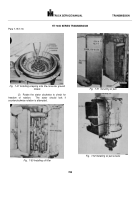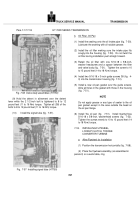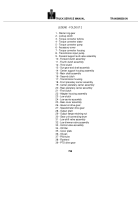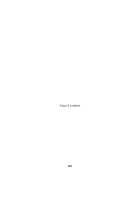TM-5-3805-254-14-P-2 - Page 801 of 894
TRUCK SERVICE MANUAL
TRANSMISSION
Para 8-1/8-5
Section 8.
WEAR LIMITS AND SPRING DATA
8-1.
SCOPE OF SECTION 8
This section tabulates wear limits and
spring data.
8-2.
WEAR LIMITS DATA
a.
Maximum Variations.
Wear limits information in
this section shows the maximum wear at which
components are expected to function satisfactorily.
b.
Cleaning, Inspection.
Parts must be clean to
permit effective inspection for wear or damage.
Refer to
Section 4, above.
c.
Bearings,
Bearing
Journals,
Bores.
The
application of bearings to any product is based on the
recommendations of the bearing manufacturer and,
therefore, no diametral dimensional deviation should be
permitted in the bearing or mated parts.
Bearings should
be carefully checked for signs of distress before
reinstalling in the transmission.
d.
Gears.
Gears should be inspected for load
pattern and signs of distress.
Any distress indicates a
possible future failure, and the reuse of such gears
should be the decision of the individual customer, based
on experience.
Backlash cannot be used to establish
critical wear of a gear.
The backlash tolerances are of
such nature that a gear usually pits, scuffs, scores, or
galls long before the gear wear becomes critical.
e.
Splines.
Unless severe, spline wear is not
considered detrimental except where it affects tightness
of an assembly such as drive line flanges.
Here, again,
backlash cannot be used to establish critical wear
because both mating parts must be concentrically
located to obtain accurate measurement of backlash.
f.
Hook-type Sealrings.
Sides of the sealring
should be smooth (maximum wear 0.005 inch (0.13
mm)).
The sides of the groove into which the sealrings
fit should be smooth (50 microinch (1.
27 iLm)
equivalent), and square with the axis of rotation within
0.002 inch (0.
05 mm).
A new sealring should be
installed if grooves are reworked, or if there is wear on
the sealring outside diameter.
g.
Oil Seals.
Seals should be replaced if they show
signs of excessive hardening, sc o ring, cracking or other
indications of deterioration.
See Section 4.
8-3.
SPRING DATA
Springs must be clean to permit effective inspection.
Springs should be replaced if there are signs of
overheating, wear due to rubbing adjacent parts, or
permanent set. Discard springs which do not meet the
loadheight specifications in the spring chart.
8-4.
WEAR LIMITS CHART
The chart which follows lists the wear limits data and
is referenced to the exploded views (foldouts 7 through
17) in the back of this manual.
8-5.
SPRING CHART
Inspection criteria (load vs height) and identification
characteristics o f the springs are presented in the spring
chart following the wear limits chart.
The spring data are
keyed to the exploded views (foldouts 7 through 17) in
the back of this manual.
NOTE
Where more than one spring part
number is listed for the same location,
refer to the HT 700 Series Parts Catalog
to determine which spring is used in your
specific assembly number.
792
Back to Top




















